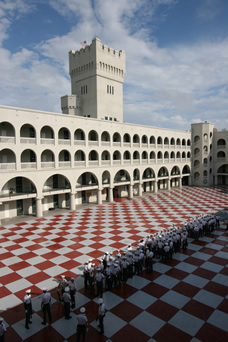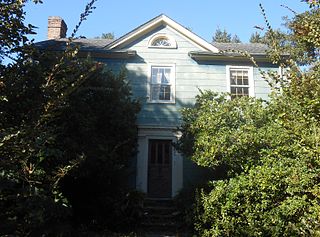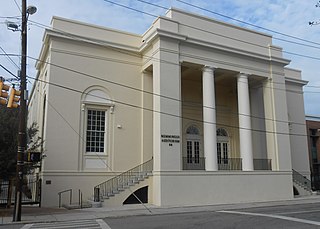
The Citadel, The Military College of South Carolina, commonly known simply as The Citadel, is a public senior military college in Charleston, South Carolina. Established in 1842, it is one of six senior military colleges in the United States. It has 18 academic departments divided into five schools offering 31 majors and 57 minors. The military program is made up of cadets pursuing bachelor's degrees who live on campus. The non-military programs offer 12 undergraduate degrees, 26 graduate degrees, as well as evening and online programs with seven online graduate degrees, three online undergraduate degrees, and three certificate programs.

Marion Square is greenspace in downtown Charleston, South Carolina, spanning six and one half acres. The square was established as a parade ground for the state arsenal under construction on the north side of the square. It is best known as the former Citadel Green because The Citadel occupied the arsenal from 1843 until 1922, when the Citadel moved to the city's west side. Marion Square was named in honor of Francis Marion.

Johnson Hagood Stadium, is an 11,500-seat football stadium, the home field of The Citadel Bulldogs football team, in Charleston, South Carolina, United States. The stadium is named in honor of Brigadier General Johnson Hagood, CSA, class of 1847, who commanded Confederate forces in Charleston during the Civil War and later served as Comptroller and Governor of South Carolina.

McAlister Field House is a 6,000-seat multi-purpose arena on the campus of The Citadel in Charleston, South Carolina, United States. It was built in 1939 and is home to The Citadel Bulldogs basketball, wrestling and volleyball teams. Office space in the facility houses athletic department staff as well as several coaches.

Henry Gilford Picard was an American professional golfer.
The 1960 The Citadel Bulldogs football team represented The Citadel, The Military College of South Carolina in the 1960 NCAA University Division football season. The Bulldogs were led by fourth-year head coach Eddie Teague and played their home games at Johnson Hagood Stadium. They played as members of the Southern Conference, as they have since 1936. In 1960, The Citadel won in its first and only bowl appearance in the Tangerine Bowl.

The 1992 The Citadel Bulldogs football team represented The Citadel, The Military College of South Carolina in the 1992 NCAA Division I-AA football season. The Bulldogs were led by sixth-year head coach Charlie Taaffe and played their home games at Johnson Hagood Stadium. They played as members of the Southern Conference, as they have since 1936.
The North Carolina Pre-Flight Cloudbusters represented the U.S. Navy pre-flight school at the University of North Carolina at Chapel Hill in the college football seasons of 1942, 1943 and 1944 during World War II. The North Carolina Pre-Flight School was established on February 1, 1942, by the Secretary of the Navy and opened that April. The football team was later organized and competed against other military teams in addition to major college teams of the period. During their three years in existence, the Cloudbusters compiled an overall record of sixteen wins, eight losses and three ties (16–8–3).
Thomas Porcher Stoney was the fifty-third mayor of Charleston, South Carolina, serving between 1923 and 1931.

The 2014–15 The Citadel Bulldogs basketball team represented The Citadel, The Military College of South Carolina in the 2014–15 NCAA Division I men's basketball season. The Bulldogs were led by fifth year head coach Chuck Driesell and played their home games at McAlister Field House. They played a member of the Southern Conference, as they have since 1936–37. They finished the season 11–19, 6–12 in SoCon play to finish in a three-way tie for seventh place. They lost in the first round of the SoCon tournament to Furman. Driesell was not retained after the season.
The President of The Citadel is the chief administrator of The Citadel. Previously known as the Superintendent, the title was changed in 1921 during the tenure of Colonel Oliver J. Bond.

The History of The Citadel began in the early 1820s with the formation of a militia and state arsenal in response to an alleged slave revolt in 1822. By 1842 the arsenal grew into an academy, with the Legislature establishing it as the South Carolina Military Academy. Cadets played a key role in the Civil War, by firing upon a federal ship three months before the war began. Many Confederate officers attended the school. Renamed in 1910 as The Citadel, the school's academic reputation grew. After moving the campus near Hampton Park in 1922, the college has grown substantially. Sixteen years after legal segregation ended in public schools, the Citadel saw the graduation of its first Black student, Charles D. Foster. After an equally rocky journey forward, the Citadel graduated its first female Cadet in 1999. The school has produced many military officers, business, and political leaders throughout its history.

The Campus of The Citadel consists of a 300-acre (120 ha) space adjacent to Hampton Park in Charleston, South Carolina. It has been home to The Citadel since 1922 when the school moved from its location on Marion Square, including the Old Citadel. Arranged with the primary buildings surrounding a central 10-acre (4 ha) parade ground, it consists of barracks for the Corps of Cadets, academic buildings, a mess hall, chapel, library, athletic and recreational facilities, support buildings, and housing for faculty and staff.
The Citadel Graduate College is the non-residential academic program at The Citadel in Charleston, South Carolina. Offering a variety of undergraduate and graduate programs in a non-military environment, the college targets residents of the South Carolina Lowcountry and distance learning students. Classes are primarily offered online or at night, using the same faculty and classrooms as the cadet day program, but students at the Graduate College generally do not share classes with members of the South Carolina Corps of Cadets. Alternatively, students can attend programs at the Lowcountry Graduate Center in North Charleston, South Carolina or through recently established distance learning programs.
Stephen Thomas was an architect who practiced mainly in Charleston, South Carolina for about 27 years.

Wagener Terrace in Charleston, South Carolina is a large neighborhood made property that had been owned by Louis Dunnemann and Capt. F.W. Wagener.

Padgett-Thomas Barracks is the dominant building on the campus of The Citadel in Charleston, South Carolina. Constructed from 1920 to 1922 as the first building on The Citadel's new site but demolished and replaced from 2000 to 2004, the barracks serves as the living quarters for up to 560 members of the South Carolina Corps of Cadets. The eight story tower which distinguishes it from the other four, smaller, barracks on Campus of The Citadel is also styled as a brand mark of the military college.
The Daniel Library is the main library of The Citadel, and is located on the college's Charleston, South Carolina campus. The library holds approximately 180,000 volumes in addition to extensive digital collections.

Memminger Auditorium is a live performance and special events venue in Charleston, South Carolina.

Meeting Street Manor is housing complex located in the upper Eastside in Charleston, South Carolina, and was the city's first housing development. When built in the 1930s, the development was technically two racially segregated halves with separate names. Since desegregation, both components are typically referred to as Meeting Street Manor, originally the name for only the Whites-only portion.















